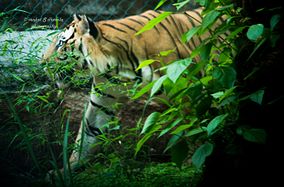Bannerghatta National Park
| Bannerghatta Biological Park | |
|---|---|
|
IUCN category II (national park)
|
|
 |
|
| Location | Karnataka, India |
| Nearest city | Bangalore |
| Coordinates | 12°48′03″N 77°34′32″E / 12.80083°N 77.57556°ECoordinates: 12°48′03″N 77°34′32″E / 12.80083°N 77.57556°E |
| Area | 260.51 km2 (100.58 sq mi) |
| Established | 1974 |
| Governing body | Ministry of Environment and Forests, Government of India |
| http://bannerghattabiologicalpark.org | |
Bannerghatta National Park, near Bangalore, Karnataka, was founded in 1970 and declared as a national park in 1974. In 2002 a portion of the park, became a biological reserve, the Bannerghatta Biological Park. It is a popular tourist destination with a zoo, a pet corner, an animal rescue centre, a butterfly enclosure, an aquarium, a snake house and a safari park. There are ancient temples in the park for worship and it is a destination for trekking and hiking. The Zoo Authority of Karnataka, the University of Agricultural Sciences, Bangalore, and the Ashoka Trust for Research in Ecology and Environment (ATREE) are collaborating agencies. Within the national park area are six rural villages enclosed within three large enclosures for sheep and cattle farming.
The 65,127.5 acre (260.51 km2) national park is located about 22 km south of Bangalore in the hills of the Anekal range with an elevation of 1245 - 1634m. The park has a hilly terrain of granite sheets under moist deciduous forest valleys and scrubland on higher areas. Sixteen villages border the park. The park is part of a wildlife corridor for elephants which connects the BR Hills and the Sathyamangalam forest. The park is contiguous with Talli reserve forest in the southeast and Bilikal forest in the south.
The park's rainfall is 700 mm per year. The Suvarnamukhi stream runs through the national park. On 15 May 2014, four bore wells were opened to provide water in dry times.
Flora in the park include:
Fauna in the park include:
One hundred and one species of birds have been recorded in the park. The fauna pose some risk to humans. In August 2012, a man was trampled to death by an elephant. Occasionally, animals leave the reserve, coming into contact with humans. For example, elephants have been sighted on the Bantamweight-Anekal road which passes close to the park. In 2007, a leopard and her cubs entered a local school.
...
Wikipedia

